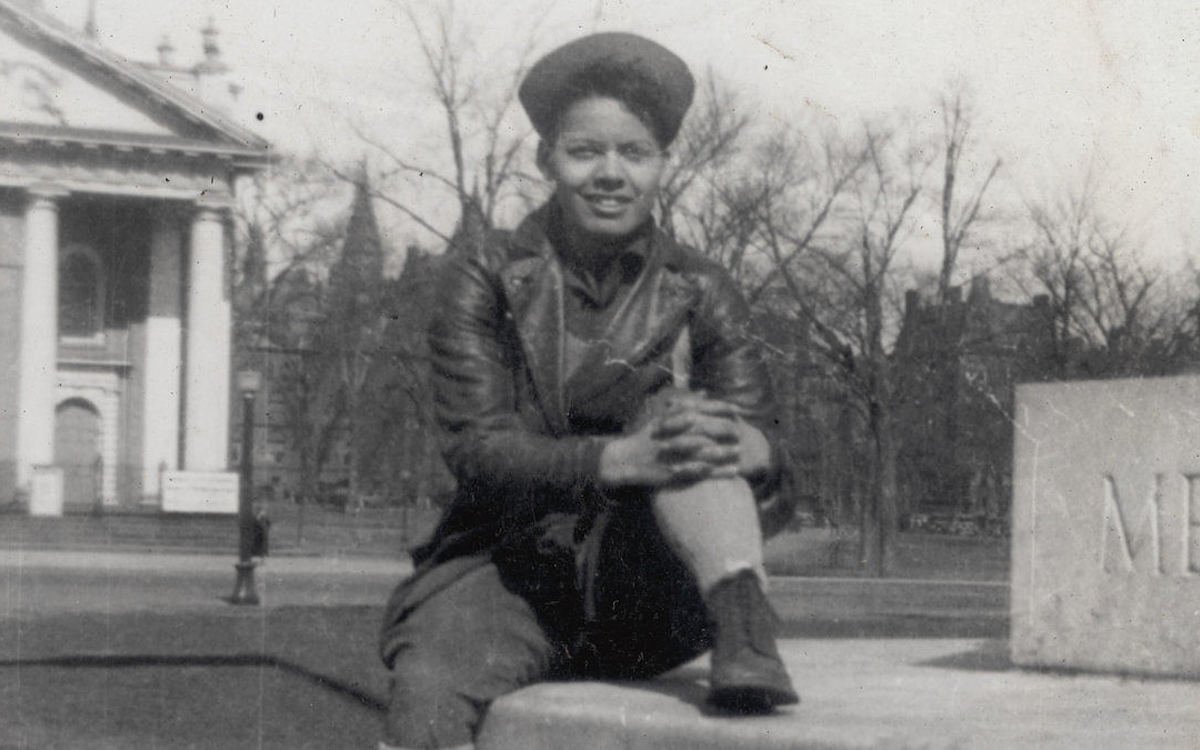Courtesy of the Schlesinger Library at Harvard University
Pronouns, Gender, and Pauli Murray
Throughout history, language and understandings about gender and gender expression have changed, contracting and expanding due to cultural, political, and/or religious influences. We do not know how Pauli Murray would identify if they were living today or which pronouns Murray would use for self-expression.
Murray self-described as a “he/she personality” in correspondence with family members. Later in journals, essays, letters, and autobiographical works, Murray employed “she/her/hers” pronouns and self-described as a woman. We also know that Rev. Dr. Murray sought gender-affirming care in different ways throughout their life.
At the Pauli Murray Center, the topic of pronouns remains an active and evolving conversation. When discussing Pauli Murray in general, we interchangeably use she/her/hers, he/him/his, and they/them/theirs pronouns, or we refer to Pauli Murray by their name and title(s).
Context about Pronouns & Gender
Personal pronouns are a way to refer to ourselves and to others.
The most common personal pronouns in the English language are she/her/hers, he/him/his, and they/them/theirs. Many people use other pronouns, such as ze/hir/hirs, which are referred to as “neopronouns.”
Some people do not use any pronouns and instead prefer to be referred to by their names, titles, or other monikers. Some people use more than one set of pronouns interchangeably.
Pronouns do not necessarily indicate a person’s gender identity. Regardless of pronouns, someone may self-describe as a woman, man, both, neither, or something else.
Click the button below to download an additional resource about pronouns!
"I don't know whether I'm right or whether society (or some medical authority) is right. I only know how I feel and what makes me happy. This conflict rises up to knock me down at every apex I reach in my career. And because the laws of society do not protect me, I'm exposed to any enemy or person who may or may not want to hurt me."
- Pauli Murray in a letter to their Aunt Pauline in 1943
Pronouns, Gender, & Pauli Murray
Courtesy of the Schlesinger Library, Radcliffe Institute for Advanced Study at Harvard
When the Rev. Dr. Pauli Murray lived, language about LGBTQ+ communities, gender expression, and gender was different than it is today. We don’t know how Pauli Murray would identify if they were living today or which pronouns Murray would use for self-expression.
Murray self-described as a “he/she personality” in correspondence with family members. For years, Murray requested - and was denied - testosterone injections and hormone therapy, as well as exploratory surgery to investigate their reproductive organs, believing that they may have been intersex and had undescended testis. Some of Murray’s own private writings describe periods where Murray seemed to self-identified as a heterosexual man. Later in journals, essays, letters and autobiographical works, Murray employed “she/her/hers'' pronouns and self-described as a woman.
Courtesy of the Schlesinger Library at Harvard University
During the 20th century, being openly queer in the United States was illegal and dangerous. In efforts to survive and maintain employment and housing, many queer, transgender, and gender nonconforming people were forced to repress or conceal their identities. Respectability politics, widespread homophobia and transphobia, and federal and state policies likely constrained Pauli Murray’s ability to publicly and thoroughly explore their gender. As Naomi Simmons-Thorne writes, “Given the rigid enforcement of the gender binary, we do not, nor will we ever know, Murray’s true gender identity."
Courtesy of the Schlesinger Library at Harvard University
Several scholars have explored Murray’s personal journals and writings and examined Murray’s relationship to their gender/s. Scholars have used “he/him/his” pronouns (Simmons-Thorne), “they/them/theirs” pronouns (Keaveney), “s/he” pronouns (Fisher), and “she/her/hers” pronouns (Rosenberg, Cooper, Drury).
This is an ongoing discussion among the Pauli Murray Center. Currently, the Pauli Murray Center chooses to use he/him and they/them pronouns when discussing Pauli Murray’s early life and she/her/hers when discussing Dr. Murray’s later years. When discussing Pauli Murray in general, we interchangeably use she/her/hers, he/him/his, and they/them/theirs pronouns, or we refer to Pauli Murray by their name and title(s). We hope this strategy will encourage readers to embrace the individual and fluid nature of gender.
Resources about Pauli Murray & Pronouns
Chandler, Dolores. “Pauli Murray: Black Revolutionary.” Scalawag Magazine, 29 January 2021.
Cooper, Brittany C. “Queering Jane Crow: Pauli Murray’s Quest for an Unhyphenated Identity.” Beyond Respectability: The Intellectual Thought of Race Women. University of Illinois Press, 2017.
Doyle, Jude Ellison S. “We’re Still Not Seeing Pauli Murray.” Medium, 28 September 2021.
Drury, Doreen M. “Boy-Girl, Imp, Priest: Pauli Murray and the Limits of Identity.” Journal of Feminist Studies in Religion, vol. 29, no. 1, [Indiana University Press, FSR, Inc], 2013, pp. 142–47.
Drury, Doreen M. “Love, Ambition, and ‘Invisible Footnotes’ in the Life and Writing of Pauli Murray.” Souls: A Critical Journal of Black Politics, Culture, and Society, vol. 11, no. 3, 2009, pp. 295–309.
Elin Fisher, Simon D. “Pauli Murray’s Peter Panic: Perspectives from the Margins of Gender and Race in Jim Crow America.” Transgender Studies Quarterly, vol. 3, no. 2, 2019, pp. 95-103.
Keaveney, Hiroki Kimiko. “Christian, Queer and Interracial: The Story of Pauli Murray and Irene Barlow.” 2016. San Francisco State University, MA Thesis.
Rosenberg, Rosalind. Jane Crow: The Life of Pauli Murray. New York, Oxford University Press, 2017.
Simmons-Thorne, Naomi. “Pauli Murray and the Pronominal Problem: a De-essentialist Trans Historiography.” Activist History Review, 30 May 2019.






